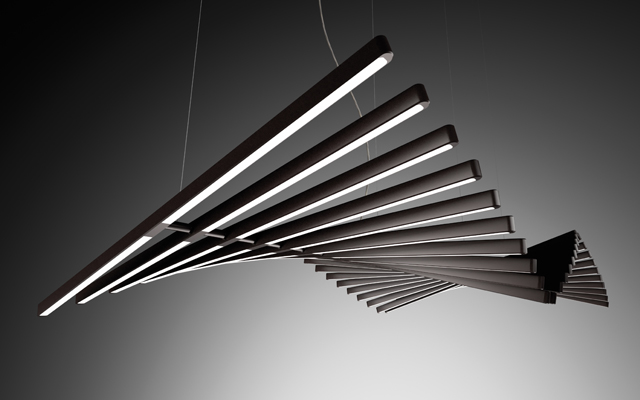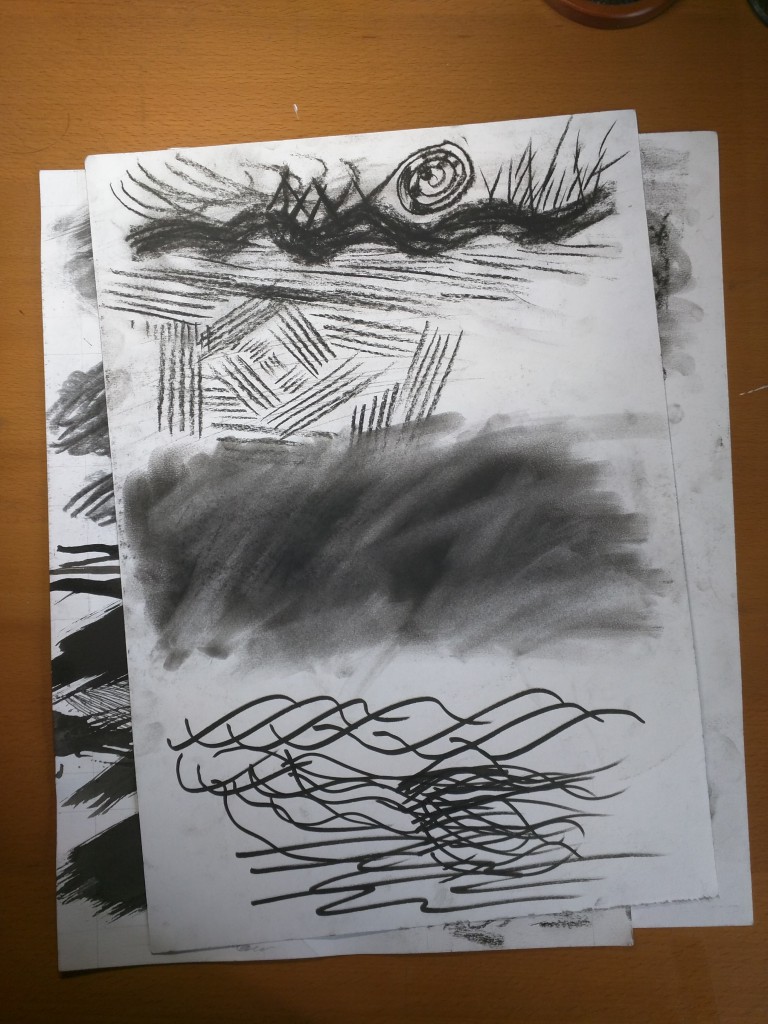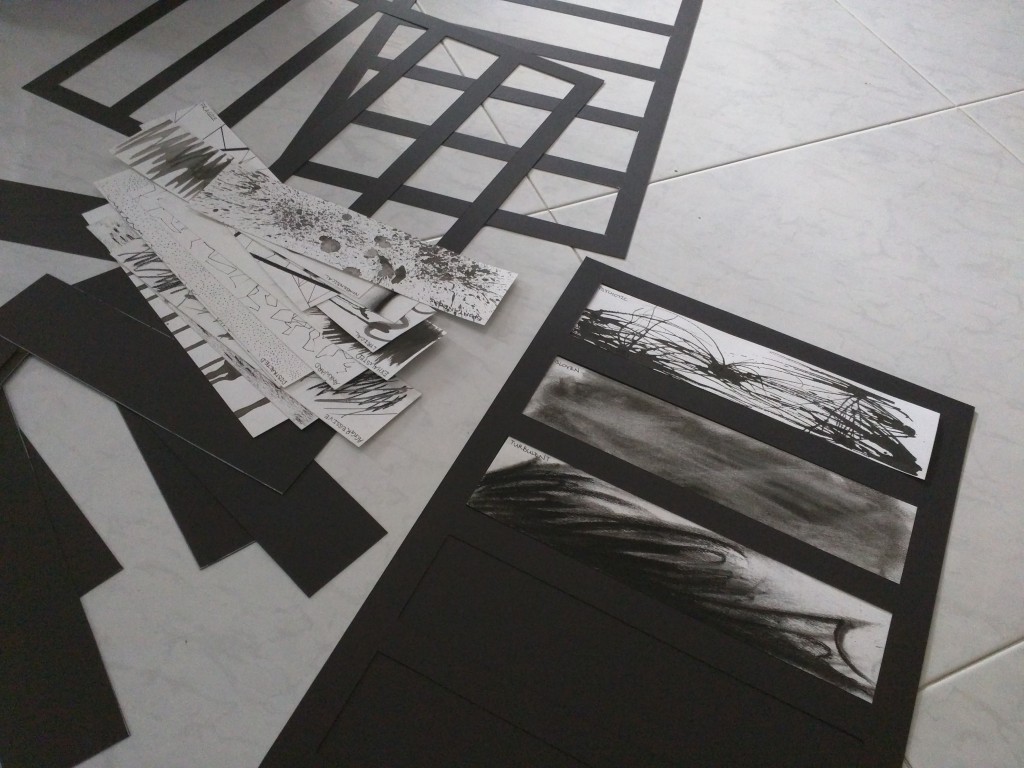“A line is a dot that went for a walk”
In order to start creating lines that represent these emotions,
i have looked up the definitions of these words
as well as coming up with my own definitions/ perspective on the individual emotions.
The definitions I have came up with are my guidelines to how i create my lines to bring out the emotions.
I then conducted my research on the various types of lines and
the meaning behind them to find suitable lines that can describe the emotions.
Also, i look up the works of various artists, studying natural lines that are found in our daily objects and environment.

PART 1: Definitions
- Anxious: feeling or showing worry, nervousness, or unease about something with an uncertain outcome.
own definition: being worried as something bad is about to happen; uncertain.
- Embarrassed: to feel awkward, self-conscious, or ashamed.
own definition: shying away from what one sets out to do.
- Bizarre: very strange or unusual.
own definition: things that look alien, does not take particular form/ incorporate too many forms.
own definition: there is a great drop in energy levels e.g. after a long run/ a long day at work.
- Fragile: (of an object) easily broken or damaged.
own definition: glass cracking.
- Systematic: done or acting according to a fixed plan or system; methodical.
own definition: has an order, pattern/ sequential. Firmness/ Rigidity.
- Lyrical: (of literature, art, or music) expressing the writer’s emotions in an imaginative and beautiful way
own definition: smooth, simple and yet very elegant.
- Turbulent: characterized by conflict, disorder, or confusion; not stable or calm.
own definition: Storm brewing; huge waves crashing.
- Nonsensical: having no meaning; making no sense.
own definitions: Scribbling without thinking. messy, almost rubbish.
- Psychotic: relating to, denoting, or suffering from a psychosis.
own definition: mad, crazy. Nervous breakdown.
- Ambiguous: open to more than one interpretation; not having one obvious meaning.
own definition: multiple perspectives to view the subject. No definite “right” or “wrong”.
- Distracted: unable to concentrate because one is preoccupied by something worrying or unpleasant.
own definition: unable to focus.
- Sensual: of or arousing gratification of the senses and physical, especially sexual, pleasure.
own definition: intimacy between males and females.
- Sloven: a person who is habitually untidy or careless.
own definition: being messy, sloppy.
- Spontaneous: performed or occurring as a result of a sudden impulse or inclination and without premeditation or external stimulus.
own definition: outburst of energy/ extremely active.
- Aggressive: ready or likely to attack or confront; characterized by or resulting from aggression.
own definition: rage, anger, violent.
- Awkward: causing or feeling uneasy embarrassment or inconvenience.
own definition: uncomfortable, inelegant/ not graceful.
- Indecisive: not providing a clear and definite result.
own definition: going round and round before coming to conclusion.

PART 2: Various types of lines and its meaning.
- Dot – A mark on a point. The defining characteristic of a dot is that it’s a point of focused attention. As dots increase in size we start to see them as shapes ( mainly circle ), but they still retain their fundamental dot-like qualities and characteristics
- Line – A line is a series of points adjacent to each other. Where a point has no dimension, a line has one dimension (length).
- Thin lines are fragile. They appear easy to break or knock over. They suggest frailty and convey an elegant quality. They are delicate and give off an ephemeral air.
- Thick lines on the other hand appear difficult to break. They suggest strength and give emphasis to nearby elements. Thick lines are bold and make a statement.
- Horizontal lines are parallel to the horizon (hence the name). They look like they’re lying down, at rest, asleep. They suggest calm and quiet, a relaxed comfort.Horizontal lines can’t fall over. They accentuate width. They’re stable and secure. The convey an absence of conflict, a restful peace. Horizontal lines by their connection to the horizon are associated with earth bound things and idea.
- Vertical lines are perpendicular to the horizon. They are filled with potential energy that could be released if they were to fall over. Vertical lines are strong and rigid. They can suggest stability, especially when thicker. Vertical lines accentuate height and convey a lack of movement, which is usually seen as horizontal.They stretch from the earth to the heavens and are often connected with religious feelings. Their tallness and formality may give the impression of dignity.
- Diagonal lines are unbalanced. They are filled with restless and uncontrolled energy. They can appear to be either rising or falling and convey action and motion. Their kinetic energy and apparent movement create tension and excitement. Diagonal lines are more dramatic than either horizontal or vertical lines.Diagonal lines can also appear solid and motionless if they are holding something up or at rest against a vertical line or plane.
- Curved lines are softer than straight lines. They sweep and turn gracefully between end points. They are less definite and predictable than straight lines. They bend, they change direction. Curved lines express fluid movement. They can be calm or dynamic depending on how much they curve. The less active the curve the calmer the feeling.
- Zigzag lines are a combination of diagonal lines that connect at points. They take on the dynamic and high energy characteristics of diagonal lines. They create excitement and intense movement. They convey confusion and nervousness as they change direction quickly and frequently. They can imply danger and destruction as they break down.
Information adapted from http://vanseodesign.com/web-design/visual-grammar-lines/
By researching on the various types of lines and its characteristics, i then map out the possible lines that compliments the emotions, as follows:
- Dot – Distracted
- Thin lines – Fragile, Sensual, Lyrical
- Thick lines – Turbulent,
- Horizontal lines – Sloven, Anxious
- Vertical lines – Systematic
- Diagonal lines – Spontaneous
- Curved lines – Sensual, Lyrical,
- Zigzag lines – Awkward, Embarrassed, Indecisive
PART 3: Finding references/ inspiration from the art world and the real world
Lastly, to sum up my research work, i tried searching online for images with interesting lines that actually portray certain emotions, and gotten some inspiration from it. I have classified my image search into two categories: Art world and Real world.
From the arts, i did some searching on artworks from renown expressionists/ abstract painters that were listed in the lesson outline like Cy Twombly, Sol Lewitt, Ed Moses, Franz Kline etc. And although i did not research extensively ( so as to generate more original ideas by my own), it provided me with insights to how artists invoke emotions through their strokes of paint.
As for the real world, i had certain references in mind that is synonymous or symbolic to the emotions listed. For example, when i see turbulent, i thought of huge powerful waves crashing in the seas. I then looked up images on waves and carefully study the types of lines and its composition that would bring out the turbulence in the waves. likewise for sensual, i interpret it as the curves on women bodies and hence, i took reference from nude models and simplified the lines to its bare-bones, allowing it to bring forth the sensual feel.
Below are some of the reference images i used. ( Disclaimer: i do not own any of these images, all downloaded from google search. Just using it to illustrate my thought process here.)






































